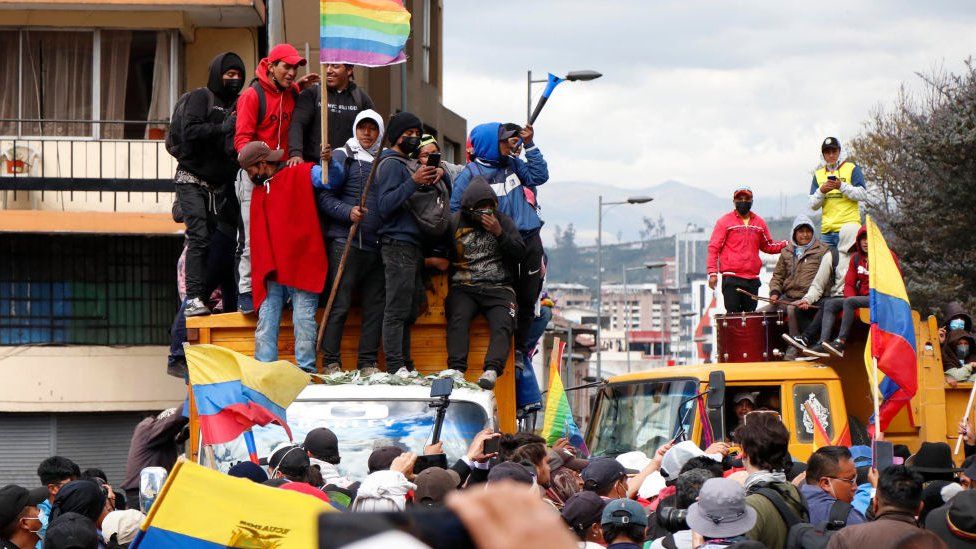Police in Ecuador’s capital Quito have fired tear gas to disperse indigenous protesters who attempted to storm Congress on the 11th day of crippling demonstrations over fuel prices and living costs.
The clashes on Thursday came after protesters won a concession from the Ecuadorian government when President Guillermo Lasso, who was isolated due to a COVID-19 infection, granted them access to a cultural center symbolizing the indigenous struggle but was requisitioned over the weekend, By the police.
Later in the day, a group of indigenous protesters, led by women, headed for the convention but were pushed back by police when violent clashes broke out.
Police fired tear gas as protesters threw rocks and fireworks.
Leonidas Iza, a protest leader who headed the CONAIE indigenous group and had previously hailed the government’s concession over the cultural center as a “triumph before battle”, expressed concern over the clashes.
“This is a very bad sign as we have asked our base to march peacefully,” he said.
The protests, which started on June 13 out of anger over prices for fuel, food, and other necessities, have killed three people and saw the government declare a state of emergency in six of the country’s 24 provinces.
An estimated 14,000 protesters are participating in the mass demonstration of discontent, and about 10,000 are in Quito, which has a curfew.
The protesters’ demands include a cut in already subsidized fuel prices that have risen sharply in recent months, as well as jobs, food price controls, and increased government spending on health and education.

Ecuador’s government allowed thousands of protesters to enter the headquarters of a major cultural organization [Karen Toro/ Reuters]
‘Because of the dialogue.’
Ecuador’s government minister Francisco Jimenez announced the concession to the cultural center earlier on Thursday, saying it was done “in the interest of dialogue and peace”.
In return, he asked for the free circulation of people and goods such as food and medicine and called for “an end to roadblocks, violent demonstrations, and attacks”.
But Jimenez said it was impossible to lift the state of emergency as demanded by protesters.
Lasso’s government also says it is responding to other protesters’ requests, including subsidized fertilizers, bank debt cancellations, and increases in health and education budgets. But it has ruled out a cut in fuel prices because it would cost the state a prohibitive $1 billion yearly.
Ecuador, a small South American country ravaged by drug trafficking and related violence, has been hit hard by rising inflation, unemployment, and poverty – all exacerbated by the pandemic.
The protests, in which tires and tree branches were burned by rowdy protesters brandishing sticks, spears, and makeshift shields, have paralyzed the capital and severely damaged the economy with barricades off major roads.
An injured protester receives medical attention during an anti-government protest in Ecuador, Quito, June 23, 2022 [Santiago Arcos/ Reuters]
On Wednesday, the Alliance of Human Rights Organizations said that a 38-year-old man was killed in the southern city of Tarqui in clashes between protesters and police, who accused it of using violent tactics.
Dozens of people have also been injured in the nationwide demonstrations that indigenous groups have vowed to continue until their demands are met.
Police, for their part, said the man had died of a medical condition that occurred “in the context of the demonstrations”.
Two other people died on Monday and Tuesday, according to the Alliance, which also reported 92 injured and 94 civilians arrested in 11 days of protests.
Officials say 117 officers and soldiers were injured.
On Wednesday evening, some 300 protesters occupied a power plant in southern Ecuador and briefly took the operators hostage, authorities said.
Official data showed that the protests caused the economy to lose about $50 million a day, not counting oil production – the country’s main export – which was also affected.
Producers of flowers, one of Ecuador’s main exports, have complained that their wares are rotting because trucks cannot reach their destinations.
CONAIE led two weeks of protests in 2019 that killed 11 people and injured more than 1,000, leading to economic losses of about $800 million before the then-president scrapped plans to cut fuel price subsidies.